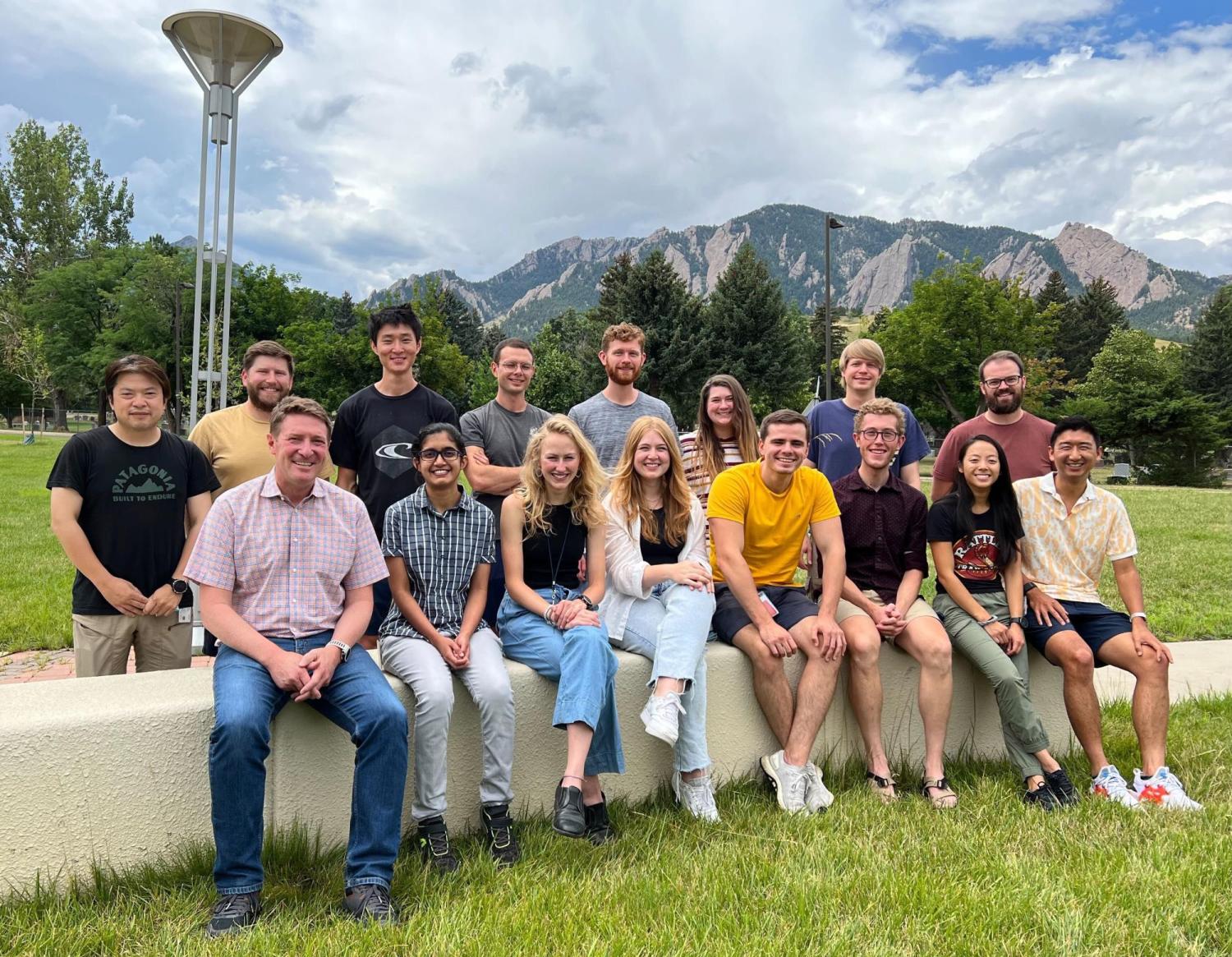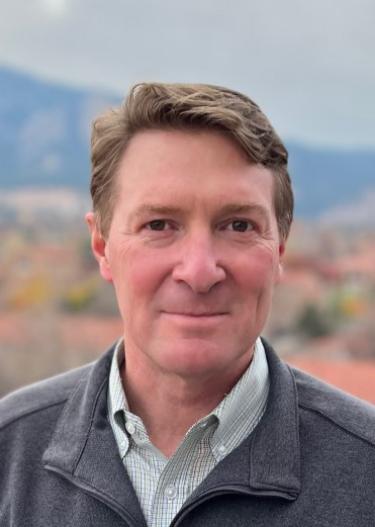Frequency Comb & Quantum Metrology Group Members

Photo taken July 2022
Bottom Row (left to right): Scott Diddams, Pooja Sekhar, Aria Mundy, Molly Kate Kreider, Igor Kudelin, Dan Lesko, Kristina Chang, Eugene Tsao
Top Row (left to right): Tsung-Han Wu, Alex Lind, Peter Chang, Will Groman, Matt Heyrich, Lauren Kennedy, Connor Fredrick, Ryan Cole
Group Leader

Professor Scott Diddams: Scott Diddams holds the Robert H. Davis Endowed Chair at the University of Colorado Boulder, where he is also Professor of Electrical Engineering and Physics. He carries out experimental research in the fields of precision spectroscopy and quantum metrology, nonlinear optics, microwave photonics and ultrafast lasers. Diddams received the Ph.D. degree from the University of New Mexico in 1996. From 1996 through 2000, he did postdoctroral work at JILA, NIST and the University of Colorado. Subsequently, Diddams was a Research Physicist, Group Leader, and Fellow at NIST (the National Institute of Standards and Technology). In 2022 he transitioned to his present position where he also assumed the role of Faculty Director of the Quantum Engineering Initiative in the College of Engineering and Applied Science. As a postdoc Diddams built the first optical frequency combs in the lab of Nobel laureate John Hall, and throughout his career, he has pioneered the use of these powerful tools for optical clocks, tests of fundamental physics, novel spectroscopy, and astronomy. His research has been documented in more than 750 peer-reviewed publications, conference papers, and invited talks. Among many awards, Dr. Diddams received the Distinguished Presidential Rank Award, the Department of Commerce Gold and Silver Medals for "revolutionizing the way frequency is measured”, as well as the Presidential Early Career Award in Science and Engineering (PECASE), the IEEE Photonics Society Laser Instrumentation Award, and the IEEE Rabi award. He is a Fellow of OPTICA (formerly OSA) and the American Physical Society, and a Fellow of IEEE.
Postdocs and Senior Research Associates
Tsung-Han Wu
(others coming soon)
Graduate Students
Pooja Sekhar
Pooja graduated from Indian Institute of Science Education and Research (IISER) Thiruvananthapuram (India) in 2019 with a BS-MS in Physics and a minor in Chemistry. Her masters research at IISER focused on studying four-wave mixing in silica fibers using continuous wave pumps at 2 micron. Pooja joined Diddams’ group in Spring 2020 and is currently working on the development of 10+ GHz frequency combs to calibrate astronomical spectrographs aimed at finding exoplanets. This work involves a combination of electro-optics, and custom nanophotonic nonlinear optics for broadband supercontinuum generation. In her free time, she enjoys hiking and dancing.
Peter Chang
Peter graduated from the University of Dallas with a B.S. in Physics. In his time there, he spent one summer at UT Austin studying plasmonic meta-surfaces coupled to multi-quantum well heterostructures and another summer at the National Institute for Materials Science (NIMS) in Tsukuba, Japan studying surface defects in Titanium Dioxide single crystals with photoelectron spectroscopy. Peter first joined the Raschke lab at CU Boulder to start his Ph.D., where he used pump probe infrared scattering scanning near field optical microscopy (IR s-SNOM) to study the transient heterogeneity in spin-coated perovskite films. He started his work in the Diddams lab in 2020 where he currently works on high rep-rate mid-infrared frequency combs for applications in dual comb spectroscopy. In his free time, Peter enjoys hiking and playing badminton and basketball.
Will Groman
Will graduated from University of California, Santa Barbara with his B.S. in Physics in 2018. His research in the FCXQM lab involves optical frequency division using self-injection locked lasers, microcombs, and micro- Fabry-Perot cavities, in collaboration with groups from around the U.S. He is interested in utilizing integrated photonic components for novel applications such as compact, low-noise, microwave and millimeter-wave generation. He enjoys playing guitar, cooking, camping in the summer, and climbing at the gym. Favorite ice cream flavor: Mint.
Matt Heyrich
Matt Heyrich is a physics PhD student at the University of Colorado Boulder. He grew up in New Hope, Pennsylvania and completed his undergraduate degree in physics at the University of Richmond. During undergrad, he worked in a variety of research areas including computational nuclear physics and theoretical biophysics, though gained interest in optics through his coursework. However, it was a SULI internship at Lawrence Livermore National Laboratory where he modeled a hollow-core photonic crystal fiber based carbon-dioxide sensor that solidified his interest in optics. In the Diddams group, Matt is happy to be working at the interface of nonlinear, ultrafast, and quantum optics as he studies electro-optic sampling, aiming to increase the technique’s sensitivity beyond state of the art by employing methods from classical and quantum optics. Outside of the lab, you can find Matt enjoying Boulder’s outdoor spaces, cooking, or playing guitar.
Sichong Ma
Sichong Ma earned his B.S in Physics from Huazhong University of Science and Technology in Wuhan, China. As an undergraduate, he did simulation work for the interference between the ionized and rescattered electron in strong-fields. In 2021, Sichong began his PhD in Physics at CU, and joined Scott Diddam’s group in the beginning of 2023. He is doing research on developing a 2-micron comb and using it to generate super-broad spectrum in Mid-IR. Outside the lab, he enjoys jogging, badminton and movies.
Carter Mashburn
Carter earned his B.S. in Physics from Michigan Technological University in Houghton, Michigan. As an undergraduate, he developed high-resolution instruments to measure various atmospheric parameters using Raman spectroscopy, such as temperature and water vapor concentration. After graduating from MTU in Spring 2021, Carter began a Ph.D in Physics at CU the following Fall. He first worked with Professor Greg Rieker on the development of mid-infrared dual-comb spectroscopy systems for environmental sensing applications and joined the FCQM group in Spring 2023. Carter's research is focused on developing UV frequency combs for broadband molecular spectroscopy. When he is not in the lab, he enjoys hiking, snowboarding, and walking his dog, Hershey.
Molly Kate Kreider
Molly Kate graduated from the University of Richmond in 2022 with a BS in Physics and English and a minor in Mathematics. At Richmond, she conducted undergraduate research modeling the optical response of Au-Al and Au-Pd alloyed thin films for applications in surface plasmon resonance-based sensors. Molly Kate joined the Diddams group in 2021 as a NIST SURF student, where she worked on modeling sources of chromatic drift in a Fabry-Perot etalon used as a calibration source in astronomical spectrographs for exoplanet detection. She is currently working on the development of a dynamic spectral flattener for frequency combs also used in spectrograph calibration. Outside of the lab, you can find Molly Kate reading, watching the latest reality tv show, trying out a new coffee shop, or learning her way around Boulder.
Dylan Meyer
Dylan graduated from the University of Alabama in 2023 with a degree in Electrical Engineering. While at Alabama, Dylan was a member of the Precision Navigation, Timing, and Frequency (PNTF) lab under Dr. Thejesh Bandi, where he worked on several projects including modeling Hydrogen MASER thermal control systems as well as creating a clock ensemble test bed in the PNTF lab. In addition, Dylan participated in several internships and summer research experiences at institutions including Dynetics, Microchip Technology Inc., and the University of Florida Precision Space Systems Laboratory. Dylan joined the FCQM lab in the fall of 2023, where his work focuses on comb-generated mm-wave time transfer techniques. In Dylan’s free time, he enjoys playing bass guitar, exercising, and perfecting his Aeropress recipe.
Jordan Wind
Jordan graduated from the US Air Force Academy in 2011 with a degree in Electrical Engineering. While at USAFA, he worked under Dr. Randall Musselman studying novel beam forming techniques using circularly disposed antenna arrays for satcom systems. After graduating Jordan served in the Air Force until 2020 when he left for a position as an engineer with Ball Aerospace working as a systems engineer designing NIR electro-optic payloads. Jordan joined Prof. Scott Diddams' group in 2024, where his work will focus on dual-comb spectroscopy techniques for measuring thermal light. In Jordan's free time he enjoys cooking, painting and spending time with his wife and pets.
Michael Wahl
Yaru (Ru) Luo
Skyler Weight
Undergraduate and High School Students
Caden McVey
Emily Jerris
Peter Zhong
Ruijian Wang
Saatwik Das
Saatwik is a current student at Peak to Peak High School. He studies and learns about optics and spectroscopy in the Diddams group. He won the Colorado EnergyWise award and the Office of Naval Research's Naval Science Research Award during the Colorado Science and Engineering Fair for his project in physics where he ranked 2nd in his division. He enjoys being a part of his Computer Science and Science National Honor Societies, and in his free time, he plays clarinet, piano, and tennis.
Alumni
Grad Students
Eugene Tsao, Ph.D. ECE (2018-2024); short postdoc at CU and moving to postdoc at ETH Zurich
Lauren Kennedy, MS, Physics (2022-2024)
Daniel Lesko, Ph.D, Chemical Physics (2017-2023); now postdoc at the University of Erlangen-Nuremberg.
Connor Fredrick, Ph.D, Physics (2015-2021); postdoc at CU & NIST and now at Honeywell
Alexander Lind, Ph.D, Physics (2015-2021); postdoc at CU and now at USNO
Holly Leopardi, Ph.D, Physics (2015-2019); now at NASA Goddard
Daniel Cole, Ph.D, Physics (2012-2018); now at Infleqtion
Daniel Maser, Ph.D, Physics (2012-2017); now professor at Connecticut College
Gabe Ycas, Ph.D, Physics (2009-2013); now at SciTec
Matt Kirchner, Ph.D, Physics (2006-2011); now at Thorlabs
Stephanie Meyer (Pierce), Ph.D. Physics (2006-2011); now at CU Denver
Jennifer Taylor, Ph.D, Univ. of Colorado (2009-2012); now at US Navy
Qudsia Quraishi, Ph.D. Univ of Colorado (2005-2008); now adjoint professor at JQI
Postdocs
Alex Lind, CU-NIST Postdoc (2021-2024); now at US Naval Observatory
Connor Fredrick, CU-NIST Postdoc (2021-2024); now at Honeywell
Kristina Chang, NIST NRC Postdoc (2021-2024); now at Octave Photonics
Igor Kudelin, CU-NIST postdoc (2022-2024); now at Nexus Photonics
Ryan Cole, NIST NRC Postdoc (2021-2023); now professor of Physics at Bates College.
Sida Xing, NIST-CU postdoc (2019-2021); now at Shanghai Institute of Optics and Fine Mechanics
Abijith Kowligy, NIST-CU postdoc (2016-2020); now at Vector Atomic
Henry Timmers, NIST NRC Postdoc (2017-2019); now at Vescent Photonics
David Carlson, NIST-NRC (2016-2018); now at Octave Photonics
Daryl Spencer, NIST-NRC (2016-2018); now at Ivani, LLC
Daniel Hickstein, NIST-NRC (2016-2018); now at Octave Photonics
Ryan Terrien, NIST-NRC (2016-2017); now professor at Carleton College
Andrew Metcalf, NIST-CU (2015-2018); now staff at AFRL, Albuquerque
Josue Davila-Rodriguez, NIST-CU (2015-2018); now at Stable Laser Systems
Wei Zhang, NIST-CU (2016-2018); now at JPL
Tara Drake, NIST-NRC (2015-2019); now professor at UNM, Albuquerque
Erin Lamb, NIST-CU (2015-2017) now at OFS
Aurelien Coillet, NIST-CU (2014-2015); now professor at Université de Bourgogne-Franche-Comté
Andrew Klose, NIST-NRC postdoc (2013-2015);
Antoine Rolland, NIST (2014-2015) now at IMRA America
William Loh, NIST-NRC postdoc (2013-2015); now at Lincoln Labs
Katja Beha, NIST-CU (2013-2015); now Professor at the University of Applied Science Munich
Fred Baynes, NIST-CU (2013-2015); now research group leader at QuantX Labs
Pascal Del’Haye, NIST-CU (2011-2015); now Group Leader at Max Planck Institute for the Science of Light
Kevin Knabe, NIST-CU (2012); now Director of R&D at Vescent Photonics
Haifeng Jiang, NIST (2011-2012); now at USTC and NTSC, Chinese Academy of Sciences
Florian Adler, NIST-CU (2010-12); now at Process Insights
Tyler Neely, NIST-CU postdoc (2010-12); now Senior Lecturer in Physics at The University of Queensland, Australia
Scott Papp, NIST-NRC postdoc (2010-13); now Group Leader at NIST, Boulder
Franklyn Quinlan, NIST-NRC postdoc (2009-13); now Group Leader at NIST, Boulder
Todd Johnson, NIST-NRC posdoc (2008-10); now Professor at College of St. Benedict and St. John’s University
Shijun Xiao, NIST (2007-09); now at CoAdna Photonics
Jason Stalnaker, NIST-NRC postdoc (2005-07); now Professor at Oberlin College
Kyoungsik Kim, NIST-CU postdoc (2004-05); now Professor at Yonsei University, Seoul
John McFerran, NIST (2004); now Professor at Univ. of Western Australia
Tara Fortier, LANL and NIST postdoc (2004-08); now Project Leader at NIST, Boulder
Tanya Ramond, NIST-NRC postdoc (2002-04); now at Sapienne Consulting
Albrecht Bartels, NIST (2001-2004); now at Novanta, Konstanz

